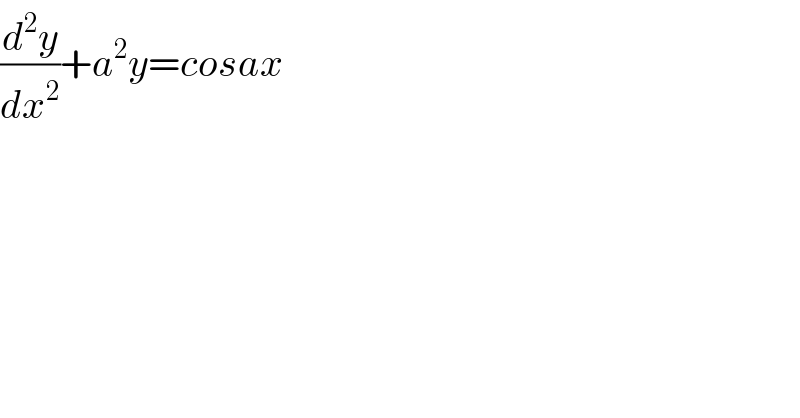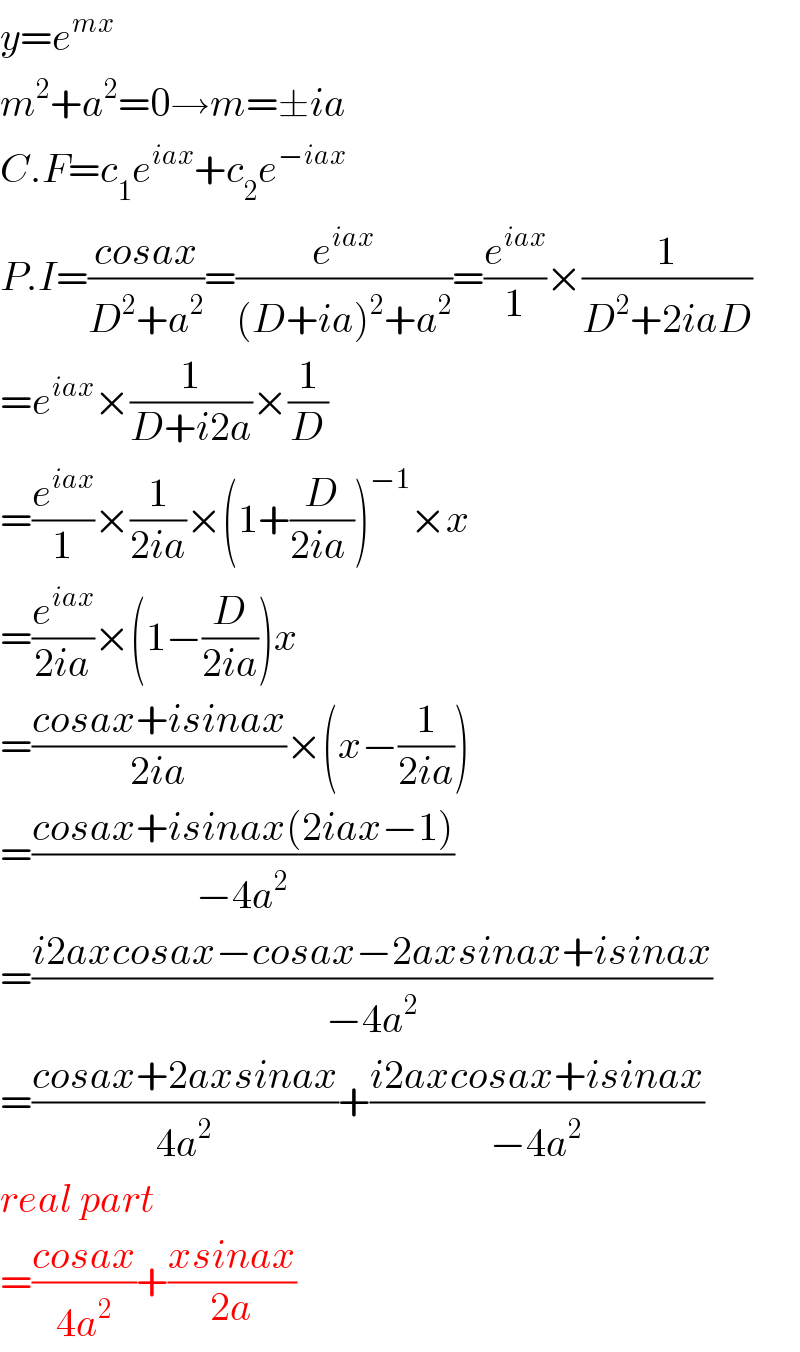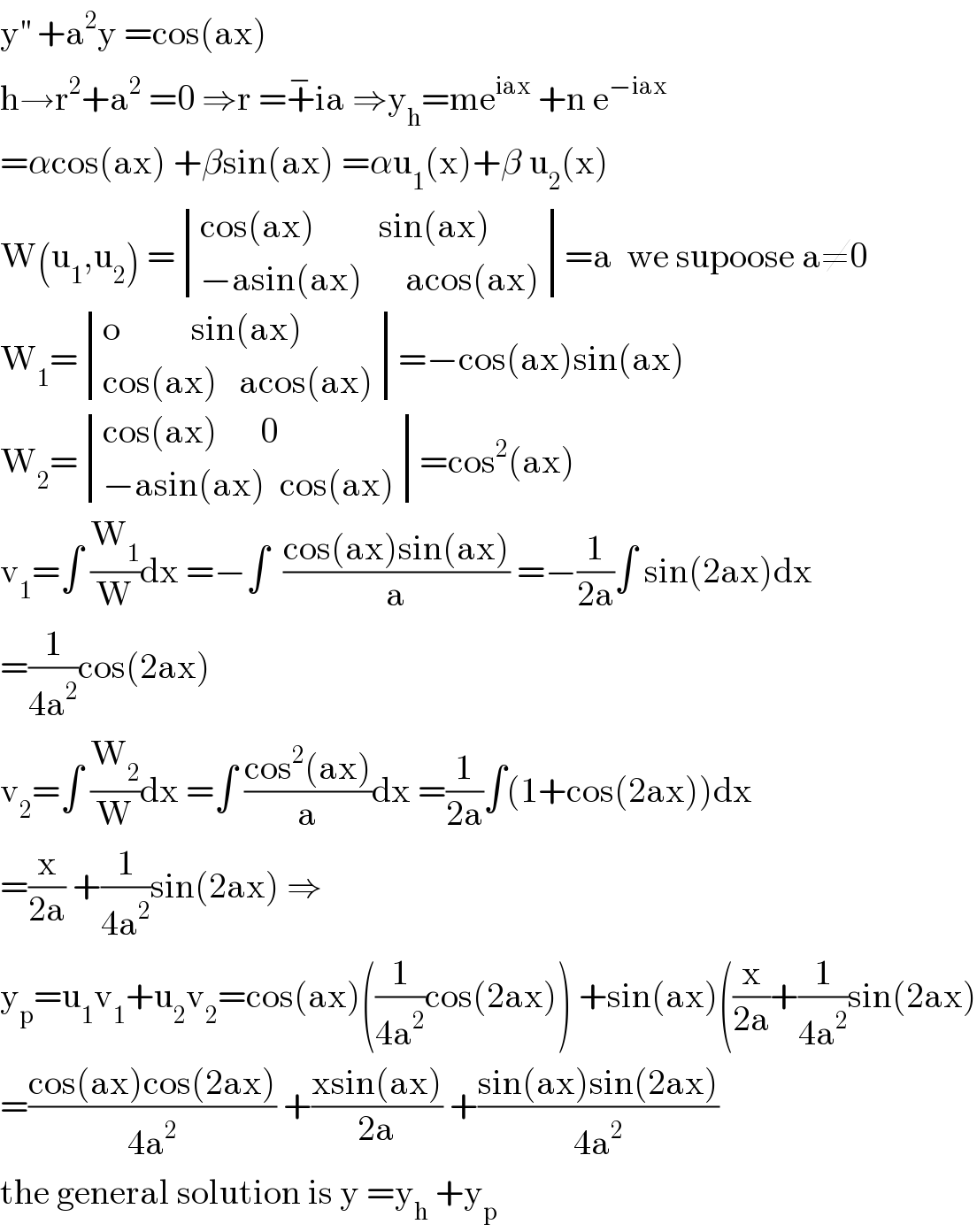Question Number 117602 by TANMAY PANACEA last updated on 12/Oct/20

$$\frac{{d}^{\mathrm{2}} {y}}{{dx}^{\mathrm{2}} }+{a}^{\mathrm{2}} {y}={cosax} \\ $$
Answered by TANMAY PANACEA last updated on 12/Oct/20

$${y}={e}^{{mx}} \\ $$$${m}^{\mathrm{2}} +{a}^{\mathrm{2}} =\mathrm{0}\rightarrow{m}=\pm{ia} \\ $$$${C}.{F}={c}_{\mathrm{1}} {e}^{{iax}} +{c}_{\mathrm{2}} {e}^{−{iax}} \\ $$$${P}.{I}=\frac{{cosax}}{{D}^{\mathrm{2}} +{a}^{\mathrm{2}} }=\frac{{e}^{{iax}} }{\left({D}+{ia}\right)^{\mathrm{2}} +{a}^{\mathrm{2}} }=\frac{{e}^{{iax}} }{\mathrm{1}}×\frac{\mathrm{1}}{{D}^{\mathrm{2}} +\mathrm{2}{iaD}} \\ $$$$={e}^{{iax}} ×\frac{\mathrm{1}}{{D}+{i}\mathrm{2}{a}}×\frac{\mathrm{1}}{{D}} \\ $$$$=\frac{{e}^{{iax}} }{\mathrm{1}}×\frac{\mathrm{1}}{\mathrm{2}{ia}}×\left(\mathrm{1}+\frac{{D}}{\mathrm{2}{ia}\:}\right)^{−\mathrm{1}} ×{x} \\ $$$$=\frac{{e}^{{iax}} }{\mathrm{2}{ia}}×\left(\mathrm{1}−\frac{{D}}{\mathrm{2}{ia}}\right){x} \\ $$$$=\frac{{cosax}+{isinax}}{\mathrm{2}{ia}}×\left({x}−\frac{\mathrm{1}}{\mathrm{2}{ia}}\right) \\ $$$$=\frac{{cosax}+{isinax}\left(\mathrm{2}{iax}−\mathrm{1}\right)}{−\mathrm{4}{a}^{\mathrm{2}} } \\ $$$$=\frac{{i}\mathrm{2}{axcosax}−{cosax}−\mathrm{2}{axsinax}+{isinax}}{−\mathrm{4}{a}^{\mathrm{2}} } \\ $$$$=\frac{{cosax}+\mathrm{2}{axsinax}}{\mathrm{4}{a}^{\mathrm{2}} }+\frac{{i}\mathrm{2}{axcosax}+{isinax}}{−\mathrm{4}{a}^{\mathrm{2}} } \\ $$$${real}\:{part} \\ $$$$=\frac{{cosax}}{\mathrm{4}{a}^{\mathrm{2}} }+\frac{{xsinax}}{\mathrm{2}{a}} \\ $$
Answered by mathmax by abdo last updated on 12/Oct/20

$$\mathrm{y}^{''} \:+\mathrm{a}^{\mathrm{2}} \mathrm{y}\:=\mathrm{cos}\left(\mathrm{ax}\right) \\ $$$$\mathrm{h}\rightarrow\mathrm{r}^{\mathrm{2}} +\mathrm{a}^{\mathrm{2}} \:=\mathrm{0}\:\Rightarrow\mathrm{r}\:=\overset{−} {+}\mathrm{ia}\:\Rightarrow\mathrm{y}_{\mathrm{h}} =\mathrm{me}^{\mathrm{iax}} \:+\mathrm{n}\:\mathrm{e}^{−\mathrm{iax}} \\ $$$$=\alpha\mathrm{cos}\left(\mathrm{ax}\right)\:+\beta\mathrm{sin}\left(\mathrm{ax}\right)\:=\alpha\mathrm{u}_{\mathrm{1}} \left(\mathrm{x}\right)+\beta\:\mathrm{u}_{\mathrm{2}} \left(\mathrm{x}\right) \\ $$$$\mathrm{W}\left(\mathrm{u}_{\mathrm{1}} ,\mathrm{u}_{\mathrm{2}} \right)\:=\begin{vmatrix}{\mathrm{cos}\left(\mathrm{ax}\right)\:\:\:\:\:\:\:\:\:\mathrm{sin}\left(\mathrm{ax}\right)}\\{−\mathrm{asin}\left(\mathrm{ax}\right)\:\:\:\:\:\:\mathrm{acos}\left(\mathrm{ax}\right)}\end{vmatrix}=\mathrm{a}\:\:\mathrm{we}\:\mathrm{supoose}\:\mathrm{a}\neq\mathrm{0} \\ $$$$\mathrm{W}_{\mathrm{1}} =\begin{vmatrix}{\mathrm{o}\:\:\:\:\:\:\:\:\:\:\mathrm{sin}\left(\mathrm{ax}\right)}\\{\mathrm{cos}\left(\mathrm{ax}\right)\:\:\:\mathrm{acos}\left(\mathrm{ax}\right)}\end{vmatrix}=−\mathrm{cos}\left(\mathrm{ax}\right)\mathrm{sin}\left(\mathrm{ax}\right) \\ $$$$\mathrm{W}_{\mathrm{2}} =\begin{vmatrix}{\mathrm{cos}\left(\mathrm{ax}\right)\:\:\:\:\:\:\mathrm{0}}\\{−\mathrm{asin}\left(\mathrm{ax}\right)\:\:\mathrm{cos}\left(\mathrm{ax}\right)}\end{vmatrix}=\mathrm{cos}^{\mathrm{2}} \left(\mathrm{ax}\right) \\ $$$$\mathrm{v}_{\mathrm{1}} =\int\:\frac{\mathrm{W}_{\mathrm{1}} }{\mathrm{W}}\mathrm{dx}\:=−\int\:\:\frac{\mathrm{cos}\left(\mathrm{ax}\right)\mathrm{sin}\left(\mathrm{ax}\right)}{\mathrm{a}}\:=−\frac{\mathrm{1}}{\mathrm{2a}}\int\:\mathrm{sin}\left(\mathrm{2ax}\right)\mathrm{dx} \\ $$$$=\frac{\mathrm{1}}{\mathrm{4a}^{\mathrm{2}} }\mathrm{cos}\left(\mathrm{2ax}\right) \\ $$$$\mathrm{v}_{\mathrm{2}} =\int\:\frac{\mathrm{W}_{\mathrm{2}} }{\mathrm{W}}\mathrm{dx}\:=\int\:\frac{\mathrm{cos}^{\mathrm{2}} \left(\mathrm{ax}\right)}{\mathrm{a}}\mathrm{dx}\:=\frac{\mathrm{1}}{\mathrm{2a}}\int\left(\mathrm{1}+\mathrm{cos}\left(\mathrm{2ax}\right)\right)\mathrm{dx} \\ $$$$=\frac{\mathrm{x}}{\mathrm{2a}}\:+\frac{\mathrm{1}}{\mathrm{4a}^{\mathrm{2}} }\mathrm{sin}\left(\mathrm{2ax}\right)\:\Rightarrow \\ $$$$\mathrm{y}_{\mathrm{p}} =\mathrm{u}_{\mathrm{1}} \mathrm{v}_{\mathrm{1}} +\mathrm{u}_{\mathrm{2}} \mathrm{v}_{\mathrm{2}} =\mathrm{cos}\left(\mathrm{ax}\right)\left(\frac{\mathrm{1}}{\mathrm{4a}^{\mathrm{2}} }\mathrm{cos}\left(\mathrm{2ax}\right)\right)\:+\mathrm{sin}\left(\mathrm{ax}\right)\left(\frac{\mathrm{x}}{\mathrm{2a}}+\frac{\mathrm{1}}{\mathrm{4a}^{\mathrm{2}} }\mathrm{sin}\left(\mathrm{2ax}\right)\right. \\ $$$$=\frac{\mathrm{cos}\left(\mathrm{ax}\right)\mathrm{cos}\left(\mathrm{2ax}\right)}{\mathrm{4a}^{\mathrm{2}} }\:+\frac{\mathrm{xsin}\left(\mathrm{ax}\right)}{\mathrm{2a}}\:+\frac{\mathrm{sin}\left(\mathrm{ax}\right)\mathrm{sin}\left(\mathrm{2ax}\right)}{\mathrm{4a}^{\mathrm{2}} } \\ $$$$\mathrm{the}\:\mathrm{general}\:\mathrm{solution}\:\mathrm{is}\:\mathrm{y}\:=\mathrm{y}_{\mathrm{h}} \:+\mathrm{y}_{\mathrm{p}} \\ $$
